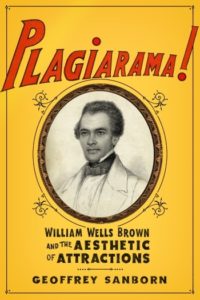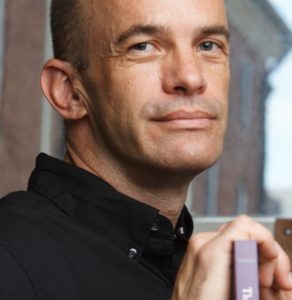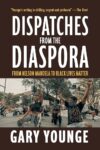Writing in her journal after an 1858 visit with William Wells Brown, Charlotte Forten Grimké reported, “He tells such ridiculous stories that although I believe as little as I please–I can’t help being amused.” Who knows which stories Brown regaled his company with. He could have chosen any episode from his wide-wandering life, or, as he was wont to do, he could have just made one up. Whatever he was doing, Brown was entertaining.
Brown is a neglected innovator of American letters. Born a slave in Kentucky, Brown had to steal an education for himself after he escaped slavery. Brown knew very well that if he wanted to get ahead in the world he’d have to engage in thievery of a kind. The first black American novelist, Brown, says scholar Geoffrey Sanborn, was motivated by his “edgy spirit of play,” and an unwillingness to accept the constraints of American fiction. Brown read widely, adapting whole passages from books he enjoyed to suit his own literary efforts. While Brown has been accused of plagiarism, Sanborn, the author of Plagiarama!: William Wells Brown and the Aesthetic of Attractions, asks his reader to consider Brown as a pioneering artist. Sanborn’s describes Brown as “one of the great American patron saints of dodginess, an artist of makeshift objects who conceives of the process of making-shift as a vital democratic starting place, a seed for the social world white and black Americans will, someday, bring fully into existence.”
Andrew Mitchell Davenport: You’ve spent an awful lot of time elucidating how William Wells Brown was “inspired” by other texts and how he incorporated them into his own work. Would you describe how you’ve gone about doing this? You mention using various online databases but I’m curious as to the scholarly work that goes on behind the scenes.
Geoffrey Sanborn: The whole thing started when I was writing an article in 2007 about some notes that Melville had taken in the back of his Shakespeare volume. I had discovered, back in 1992, that many of the notes hadn’t been generated by a Shakespeare-inspired creative frenzy, but by something really ordinary; Melville had been reading an article in an old magazine and had used the blank pages to copy down some passages from it (he later used one of the passages in Moby-Dick). I had started playing around with Google Books in 2007 and realized that if I hadn’t randomly run across that article in the UCLA library stacks, somebody would have eventually phrase-searched the notes on Google Books and found the article that way. There were other notes in the back of the Shakespeare volume that hadn’t come from the article I found, so I started phrase-searching them and found out where they came from. It was fun—I’m not sure how to describe the feeling, but I liked it. It’s probably related to what lab rats feel when they hit the right lever and the food comes out. I was teaching Brown’s Clotel at the same time, and there was one passage in it that was so weird, tonally, that it stood out against the background of a book with more weird tonal shifts than any book I have ever read. It’s about the Roman Empire, and it goes, “Where is her splendour, her wealth, her power, her glory? Extinguished for ever. Her mouldering temples, the mournful vestiges of her former grandeur, afford a shelter to her muttering monks.” Just for fun, I phrase-searched “her muttering monks.” It turned out that not only that phrase, but a whole nine-sentence passage had been lifted from a Fourth of July oration by someone named Milton Maxcy.
So that’s how it started. I phrase-searched my way through Clotel on Google Books, sort of as a hobby, and found a lot of other sources. I wasn’t sure why it would be interesting to anyone else, at that point, because scholars had know for quite a while that Brown had used huge chunks of a story by Lydia Maria Child in Clotel. Why would it matter that he used huge chunks from elsewhere as well? I’ve never had any sense of outrage in me about plagiarism in works of literature. It’s always felt to me like you’re sort of not yourself anyway when you’re writing creatively, like you’ve gained entry to a room in which a lot of different voices are audible, like you’re writing down things that don’t obviously originate in you. That’s part of why it feels good to do it, I think. You get tired of being just one person. I do, anyway.
But then I phrase-searched his other books (he wrote eight of them and revised and republished several of them). And then I discovered these subscription databases, like America’s Historical Newspapers, American Periodical Series, and Slavery and Anti-Slavery, and re-phrase-searched all the books. Not every library subscribes to them, so I would drive from Bard, where I was teaching then, to the library at Vassar and find lots of new stuff that way. When I couldn’t do that anymore, after I took a job at Amherst, someone at NYU let me borrow her library ID and password and I searched that way. I also went to the New York Public Library and the Columbia library. And all this time, more and more nineteenth-century newspapers and periodicals were getting digitized, so that when I would go back to databases that I hadn’t used for a couple of years, I would find new things in them.
It took about four years of this before I realized what I was finding out, which was that Brown’s plagiarisms were part of a really distinctive compositional aesthetic. I wrote Plagiarama! because I fell in love with that aesthetic and I wanted to give other people a sense of what it’s like. I tried to describe it as briefly as possible to someone at a conference once, and condensed it into “modal dissonance,” and I could see the light go on in her eyes, so that’s become the description of it that I use most often. Basically, my argument is that Brown likes it—and thinks that other people like it—when writing hard-shifts from one mode into another, when sentiment suddenly stops and comedy suddenly starts, say, or when a character with a distinctive idiom gets in a back-and-forth conversation with a character who speaks in a sharply different idiom. Plagiarism was, for him, a way of creating that effect. It was other things too—a way of making writing pleasurably continuous with reading, a way of tuning in to the interestingly different frequencies of other people’s styles, and, no doubt, at times a way of saving time and filling space—but what it was most often was a generator of modal dissonance.
There’s a crucial difference between the way, say, Melania Trump or Monica Conway plagiarize, and William Wells Brown’s appropriations. Would you describe how you differentiate between out-and-out plagiarism and plagiarism as an aesthetic endeavor?
In one of the footnotes to Infinite Jest, David Foster Wallace theorizes that most plagiarists are “navigationally insecure,” by which he means that they are quickly and easily overwhelmed by the question of what’s going to happen next. He’s thinking in particular about students plagiarizing in papers, but it applies to a lot of other writers or speakers too. You’re at a loss for words, you’re casting about for them in a pain-inducing way, and then right there in a book or on a screen are some words that instantly relieve that pain.
The kind of plagiarism that results from this kind of insecurity is usually not very aesthetically interesting. It feels workmanlike, like it’s there to get a job done. (I discuss a couple of nineteenth-century examples of this type of plagiarism in the book.) And if there’s a steep stylistic gradient between the plagiarized passage and the writing that surrounds it, the writer usually tries to smooth it out, so that it seems like there’s only one voice on the page, only one mind at work.
The plagiarism in Brown’s work—and, in different ways, the plagiarism in the work of Pauline Hopkins, Nathaniel West, and Kathy Acker—is not like that. Very often, as in the case of the passage from Clotel that I just mentioned, Brown seems to be trying to make the gradient between passages as steep as possible. Here’s an example: at one point in Clotel, a character named Snyder launches out of nowhere into an oratorical flight—“Whatever institution reflects discredit on industry, whatever institution forbids the general culture of the understanding, is palpably hostile to individual rights, and to social well-being”—that’s lifted word for word from a book called Papers on the Slave Power, and then we get this sentence: “‘Yes,’ interrupted Huckelby; ‘them’s just my sentiments now, and no mistake.’” Here’s another: Brown uses a minister in Clotel as the mouthpiece for a borrowed temperance speech that ends, “I have known honest men whom it has made villains—elegant and Christian ladies whom it has converted into bloated sots,” and then begins the next paragraph like this: “‘But you talk too fast,’ replied the white hat man. ‘You don’t give a feller a chance to say nothin’.’” Brown isn’t satirizing any particular character; he’s just having fun with language, using plagiarism to sharpen a pleasurable contrast between high-cultural and low-cultural idioms.
Clotel is often referred to as a kind of artistic failure. What’s your take on Brown’s novel?
I love Clotel, but I didn’t always love it. One of the problems that I had with it, back when I was first teaching it, was that I was searching for, and not locating, a singular consciousness that was expressing and discovering itself in the act of writing. The best-ever article on Brown, by Ann duCille, is called “Where in the World is William Wells Brown?”, and that’s exactly what I was trying and failing to discover in Clotel. What changed things for me was that I started to get interested in the fact that he wasn’t spiritually inside every word on the page and that he wasn’t transcendently above them either. I started to see that he was, very often, between blocks of text, maneuvering them into relation with one another. I started to see that he thinks of writing not as a means of soul-baring or soul-making but as a means of transmitting energy and evoking companionability. Reading Clotel is, for me, an experience of going nowhere in particular in the company of someone who thinks that we’re all pretty comical creatures, prone to magnifying our brief, fragile, minor selves into fantastically oversized and contorted shapes. Slavery and racism are two of the products of that tendency, and part of what makes them so horrific is that they violently repress their ludicrousness. In Brown’s textual world, we get the return of that repressed—we encounter a mode of anti-slavery and anti-racism that consists of disclosures of ludicrousness, disclosures that, over time, are capable of accustoming us to a shareable unseriousness about all of our selves. That’s what it feels like to me, anyway.
Is there any evidence that allows us to consider how Brown read? Did he read with scissors in hand? Did he file choice excerpts away for future use?
There’s no direct evidence—there’s no books that he owned with marginalia in them, no letters describing the way that he read—but we do know that a great many mid-nineteenth-century readers kept what were called commonplace books, in which they would either transcribe or paste in passages that they wanted to remember for some reason or other. In Clotel, which Brown wrote in England, there are passages lifted from American newspaper articles that it would have been unbelievably unlikely for him to have encountered in England—a 1849 Albany newspaper story about a tenement fire in Buffalo, for instance. It seems very, very likely to me that he kept a commonplace book in which he copied or pasted things that he thought he might be able to use later on, either in lectures or in publications.
You’ve done a marvelous job of demonstrating Brown’s creative sensibilities. You write that Brown seems to have been motivated by “an edgy spirit of play.” Would you elucidate this for a reader who may not be that well acquainted with the author? It seems to me that we should reconsider Brown as an American humorist on the order of, say, Barnum or Twain.
I totally agree that he is part of an American lineage, an American literary heritage, in which Barnum and Twain are located as well. I feel a little bad about the degree to which I used Frederick Douglass as a foil to Brown in Plagiarama!, because I really like Douglass too, but the most economical way of conveying Brown’s creative sensibilities is by contrasting them with Douglass’s. Brown was the second-most-famous black abolitionist, after Douglass, and the path that he blazed for himself was pretty clearly conceived of by him as an alternative to the path that Douglass had blazed. Douglass had done the imposing, the overawing, and the magisterial so sublimely that no one, black or white, could hope to compete. What Brown chose to pursue, both because it was his temperamental inclination and because it was a glaringly available market niche, was a mode of speaking and writing that felt less exclusive, less field-controlling. He spoke and wrote in a range of voices, and he did so in a way that was highly attuned to how funny it can be when a person speaks or writes in a specialized, self-fetishized voice, as if he or she is an achingly rare spirit with a language that is all his or her own.
I find this appealing in the same way that I find Barnum and Twain appealing. Barnum’s fakery was incredibly easy to see through; it made the visitors to his museums feel, paradoxically, in on the joke that he was pulling on them. In “Those Extraordinary Twins,” an essay about the composition of Pudd’n’head Wilson, Twain writes, “Would the reader care to know something about the story which I pulled out? He has been told many a time how the born-and-trained novelist works. Won’t he let me round and complete his knowledge by telling him how the jack-leg does it?” Like Barnum and Twain—and unlike Douglass—Brown brought his readers and audiences closer to him by indicating at every turn that there was nothing sublimely genius-like about the origins of his performances. It was all, for him, a DIY seizing of opportunity, a taking-advantage of what was, in one of Huckleberry Finn’s favorite words, “handy.” He’s one of the great American patron saints of dodginess, an artist of makeshift objects who conceives of the process of making-shift as a vital democratic starting place, a seed for the social world white and black Americans will, someday, bring fully into existence.
Andrew Mitchell Davenport is an editor of Full Stop and The Scofield, and was recently named a Robert H. Smith Fellow at the International Center for Jefferson Studies.
This post may contain affiliate links.









